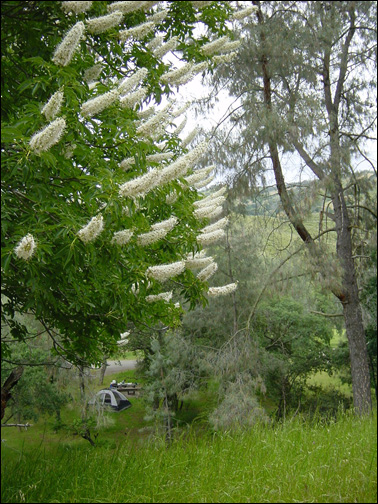
by Susan Labiste
NUTS
California buckeye (Aesculus californica): The buckeye fruit required more leaching than acorn, but was used as a food by Ohlone Peoples (Bocek 1984:252). Without proper leaching this large nut-like fruit is toxic, containing aesculin, a coumarin glycoside (Fuller and McClintock 1986:178). Buckeye processing for tribes north of the Chumash is similar to Chumash processing of holly leaf cherry i.e. islay (Timbrook 2007:152). This is a productive tree. An acre of mature buckeye trees is estimated to produce 4.4 tons of fruit per year. However it has little protein or fat, requires repeated hot water leachings, yields less edible meal per pound than acorn, and was said to have an inferior taste when compared to acorn. For all these reasons, it was generally considered a less desirable food (Heizer & Elsasser 1980:100).

California buckeye flowers on the left and a Grey pine on the right of the photo.
California black walnut (Juglans californica) Harrington’s notes indicate it was eaten by the Ohlone (Bocek 1984:248). This native walnut has a harder shell, and sweeter taste than the English walnut sold commercially (author).
California hazel (Corylus cornuta): Harrington’s notes indicate the nut was used as a food, but only late in the season (Bocek 1984:248). Nuts mature August to September (author’s experience). Evidence of its use by Ohlone is seen in charred hulls found in archaeological sites (Bean 1996:267). Having gathered these myself in the wild, I can attest to the fact they are as enjoyable as the filberts sold in grocery stores (author).
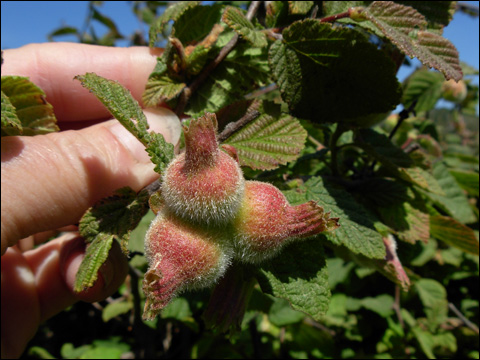
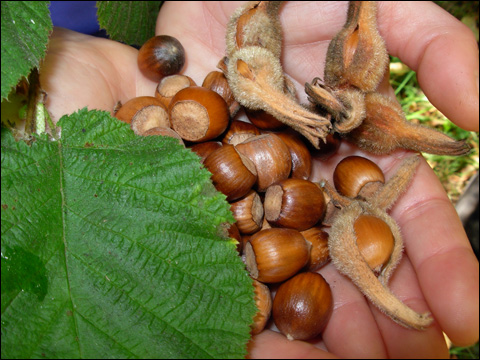
Hazel nuts
California bay laurel, Oregon myrtle, peppernut or Bay tree (Umbellularia californica): The tree fruits during the summer. It is related to the avocado. The pulpy flesh around a shelled seed resembles avocado when it is ripe. I have found the ripened flesh palatable, though it can be unpleasant when not fully ripe (author). The kernels, when baked until they are browned like coffee with cream, have a delicious smell. They are oily with a slightly bitter aftertaste. I am fond of them, but find I must limit the number eaten to no more than 5 as they have a stimulant effect not unlike coffee (author). Nuts mature in late October to November (author). Harrington confirms its use by the Ohlone, stating “the fruit could be eaten raw or boiled (apparently the outer pulp covering the nut) and the nut kernels were either roasted or ground into flour for cakes” (Bocek 1984:249).
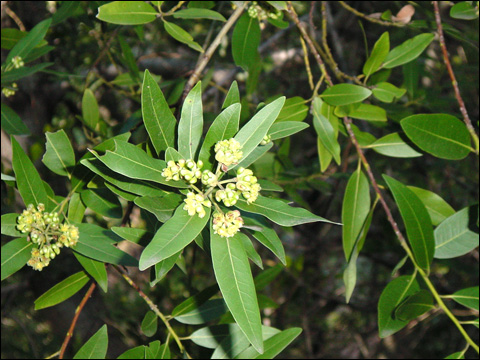
California bay laurel
Grey pine, Ghost pine, (and the ethnically offensive common name of Digger pine) (Pinus sabiniana): Its large, hard-shelled nuts were prized by other native groups as a food and as a bead throughout much of its range (author). (Bocek 1984:248). Charred remains of the seed appear in Ohlone archaeological sites in San Jose area (Bean 1994:267). In Tulare, the Indians are described gathering and burning a three hundred pound pile of the pine cones to open and obtain this rich food resource (Mayfield 1928:67). Harrington’s notes confirm it was eaten by the Ohlone.
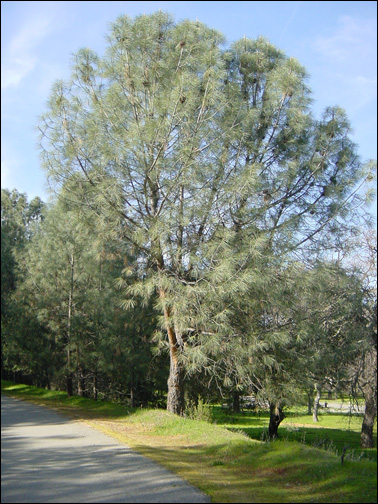
Grey pine trees at Del Valle Regional Park.
Holly leaf cherry, Islay (Prunus ilicifolia): Though this plant is named a cherry, and shares a family with many domestic fruits, there isn’t much fruit overlaying the pit. The bush can bear heavily (author).
Harrington’s notes document its use by the Ohlone. The cherries are placed in water and all the fruit layer is removed and thrown away. The pit is allowed to dry a little, then shelled. The kernel inside is placed in warm water with sugar (modern) to sweeten the kernels. Then they make a hole in the ground, line it with soft grass, and roast the kernels overnight. After roasting they are taken out using a walaheen (sifting basket) and served. Though this entry implies the outer fruit layer was not eaten, a second entry states the fruit was occasionally eaten (Bocek 1984:244-245, 246), (Timbrook 2007:152 from Saunders 1920:5, 7-58).
To the south, islay was an important Chumash food. I’ve included the Chumash preparation of islay, as it is more detailed and may be similar to the Ohlone method. The Chumash picked the fruit and allowed the outer fruit to rot enough to make it easy to rub it off with the hands or wash it away in water. The pit, encased in its own shell was then either boiled for a short time or hot water was poured over the pits. Pits could then be dried and stored for a long time. Red and green islay were kept separately. The shells of the green islay were burned. Water was added to this ash and it was later molded into cakes used in the cooking process.
The kernel (essentially the pit) contains cyanide, as does the kernel of other Prunus spp. including domestic plums and apricots. All bitterness had to be removed before it could be eaten. Three Chumash techniques for leaching are described by Harrington’s consultants: Kernels were shelled. Whole shelled kernels could be placed in a sack and repeatedly dipped in hot water. The shelled kernels could be mashed and placed in a basket, then placed in a stream to allow the cold water to run through it. Or the whole, shelled kernels could be heated in water until nearly hot enough to boil. Then the water would be discarded and the steatite bowl refilled with cold water and heated again. The water required 3 changes for fresh islay and only 2 for islay that had been stored
After leaching, the Chumash boiled the kernels using direct heat in a steatite olla. Covered with water, they were boiled for several hours (Ohlone apparently did not use steatite ollas, but did use earth ovens - author). The ashcakes made from green islay were then used by some cooks. Added in an amount equivalent to twice the last joint of a finger, it was said to remove any residual bitterness. When the islay was soft, it was done. It was then mashed with a wooden paddle, shaped into balls, rolled in pinole flour from juniper or grass seed, and served on a basket tray. It was said to resemble beans in taste and in color. The prepared islay could be kept for a week (Timbrook 2007:151-154).
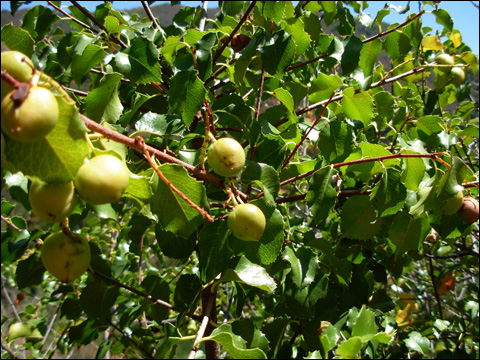
Holly leaf cherry
Oaks (Quercus spp.): Very productive wild crop with measured yields of 500 to 1,000 pounds per large tree (Heizer & Elsasser 1980:91-101). It is suggested that much of the Ohlone population moved to the hillsides during the fall to gather seasonal resources of acorn and to hunt deer (Bean 1994:48).
Acorns, like many Native foods, are dried for storage. A Wukchumne Yokut family might need to gather and store 1,000 pounds of acorn to meet their annual needs (Jacknis 1984:48 from Latta 1949:105).
There are many accounts of acorn processing which vary from region to region. Most involve removing the shell or hull and any membranes adhering to the acorn. The nutmeat is then usually pounded into flour, sifted and pounded further until quite fine, then taken to a sandy area near water to be leached. The leaching process usually involves making a carefully constructed basin of dampened sand, or it was placed in a leaching basket (Ortiz 1991:69, 85, 97). The Ohlone used both methods (Jacknis1984:45 from Gifford, 1936:89). Some groups line their sand basins with leaves, and some do not. The acorn meal is placed in the basin or basket and water is poured over it. It percolates through the meal and carries away the bitter tannins found in acorn. Without leaching, the tannins in acorn can be toxic. Cooking of leached acorn usually involved boiling it in a basket with red-hot stones (Ortiz 1991:69, 85, 97). For a detailed account of acorn processing, see “It will live Forever” by Ortiz. I have not seen a detailed account of Ohlone traditional acorn processing.
Within Ohlone territory most pounding was done on large bedrock mortars, but the smaller portable mortar was not unknown. It is believed that the rounded and shallow mortar holes were used for acorn while the deeper and more v shaped mortar holes were used for seeds and certain berries (Bean 1994:46).
Labor is involved in leaching acorn. There have been some attempts to quantify the labor involved. A Yokut woman consumed much of a day to pound 50 pounds of acorn into meal, enough to feed an average family for 2-3 days. A Hupa woman recounts leaching 3.5 pounds (56 ounces) for 2 hours and 34 minutes, and ended up with 5 pounds, 4 ounces (84 ounces) of leached meal (leached meal contains more water, so it weighs more than the unleached meal) (Jacknis 1984:47 from Gayton 1948:178 and Goldschmidt 1974:311-13). The leached meal could be made into acorn mush, acorn soup or acorn bread. The preferred consistency of acorn soup was not the same for every group in California.
Although acorn is not currently a common food item in modern American life, both European and Mediterranean history record acorn as a food source (Jacknis 2004:150).
Blue oak of warmer inland hills (Quercus douglasii): Average production per tree is 160 pounds, but it fruits well only every 3 years (Stevens and Ryan 1997:19).
Black oak of higher hills (Quercus kelloggii): Average yield is 200 to 300 pounds per tree (Heizer & Elsasser 1980:95), but fruits well only every other year. Nuts mature in October (author’s experience). Harrington’s notes confirm its acorn was used for food by the Ohlone (Bocek 1984:248).
Valley Oak of fertile valleys (Quercus lobata): Its average yield can be 350 to 500 pounds, but it fruits well only one in 3 years (Stevens and Ryan 1997:19). Its use by the Ohlone is confirmed by Harrington’s notes (Bocek 1984:248). This acorn matures earlier than most others in this area, usually in September (author’s experience).
Coast Live Oak of coast and valley hillsides (Quercus agrifolia): It produced the favored acorn of the Ohlone Peoples (Bocek 1984:248). The tree yields over 200 pounds per tree (Timbrook 2007:161). Acorns mature in 6 to 8 months (Stevens and Ryan 1997) usually in October (author’s experience).
Canyon or Maul oak is a less common inhabitant of local canyons (Quercus crysolepis): This tree may produce 150 to 200 pounds of acorn every year (Stevens and Ryan 1997:19).
Tanoak of the coastal fog belt (Lithocarpus densiflora) (Hickman 1993:658): Harrington’s notes indicate the acorn was used as a food by the Ohlone (Bocek 1984:248).
SEEDS
Although acorn is often sited as the staple food of this area, in 1769 the Spanish were offered pounded seed mixtures in large quantities. Grass and other seeds may have been the most important starchy food source in the San Francisco Bay Area (Jacknis 2004:12). These pounded seed mixtures were termed pinole.
Seeds were knocked from plants with seed beater baskets. The falling seed was captured in gathering baskets. Seed was then parched by heating, tossed in the air to winnow away the chaff, pounded into flour and eaten in a variety of ways (Jacknis 2004: 129). Powers makes note of the Native Peoples near Gualala (not Ohlone) gathering large quantities of “wild oat” in conical baskets (we do not know for sure what grass species he refers to). Seed beaters were used to sweep over top of the grass, shattering the ripe grain into a large conical basket held by the other arm. For this group, the gathering was apparently done by the men. Women were described threshing the dampened seed with sticks, churning it until the chaff rose to the top where it was burned away with a firebrand. The seed was then prepared for pinole by pounding and parching, or made into bread (Powers 1976:187). Powers notes were made in the early 1870s. Pomo and Ohlone seed beating techniques were identical (Bocek 9184:245).
Native grasses: Seed mature in June, July and August.
California fescue (Festuca californica) and Purple needle grass (Nasella pulchra): These are two common native bunch grasses (Hickman 1993:1236).
Wild oat (Avina fatua): This grass was apparently introduced to California during the Mission era of the 1770’s. However, this seed was soon utilized by Native Peoples. Powers documents its use, but not for a specific culture (Powers 1976:425).
Bromus virens: Powers documents its use, but not for a specific culture (Powers 1976:424-425).
Blue wild rye (Elymus glaucus synonym Hordeum glaucum): This grass is listed by Beverly Ortiz as used by the Ohlone in her EBRPD reference. Harrington’s notes list Hordeum spp. as a seed in pinole (Beck 1984:255).
Wild rye (Elemus californicus): Used by Hopland Pomo as a seed resource. Seeds were parched with coals and winnowed (11/06/05 CNPS lecture by Charles Kennard). Elemus glaucus is listed by Beverly Ortiz in her EBRPD reference as a species of wild rye eaten in pinole by the Ohlone.
Big leaf maple (Acer macrophyllum): The winged seeds were sometimes eaten by the Ohlone (Bocek 1984:248). This seed is larger than most of those used for pinole, and may have been eaten separately (author). It is available in summer.
Chia (Salvia spp.): Listed by Beverly Ortiz as a primary food of the Ohlone served with other seeds in pinole (Bocek 1984:253). Mature seeds available in July (author).

Close-up of Chia flowers.
Coastal tarweed (Hemizonia corymbosa): The seed was gathered by Ohlone and prepared as pinole (Bocek 1984:254). The seed is available in late August to October (author).
Lupine (Lupinus spp.): Unspecified species listed as a seed used by the Ohlone in pinole (Bocek 1984:250). Some species of Lupine seeds are toxic (Fuller & McClintok 1986:160). There was no reference to what species was used by the Ohlone or if it was processed to remove toxicity (author).
Narrow leaved mule ears (Wyethia angustifolia): This seed was used by the Ohlone in pinole and the stem was eaten raw (Bocek 1984:255).
Red maids (Calandrinia ciliata): The seed of this plant is listed as used by the Ohlone, and was gathered in great quantity (Bocek 1984:251). These bright magenta-colored flowers arrive in April. Seed is usually available April to May. By summer it has usually dried beyond recognition. It requires good light, and its growth was encouraged by the land management techniques of Native Peoples. Plants sprouting from recent burn sites are larger and more robust. Routine burning helped create favorable habitat for seasonal seed bearing plants like Red maids (author).
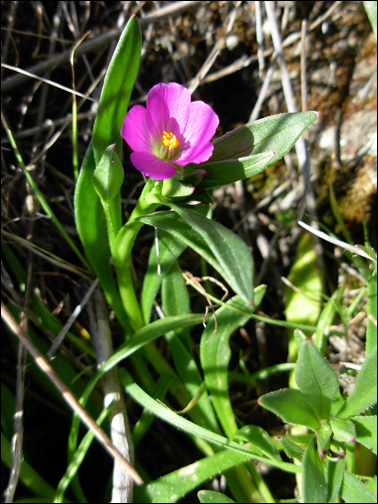
Red maids
Rough cockleburr (Xanthium strumarium var canadense): Identified as a seed added to pinole by the Ohlone (Bocek 1984:255).
Sunflower, Mirasol (Helianthus annuus): The Ohlone ate the seed, but not usually in pinole (Bocek 1984:254). Seed available in summer (author).
Tarweed (Madia spp.) including Madia salvia: These late blooming yellow flowers begin to grace dry hillsides in July and August. Seeds mature September to October. Powers documents their use, but not for a specific culture, claiming they are as rich as butter (Powers 1976:424).
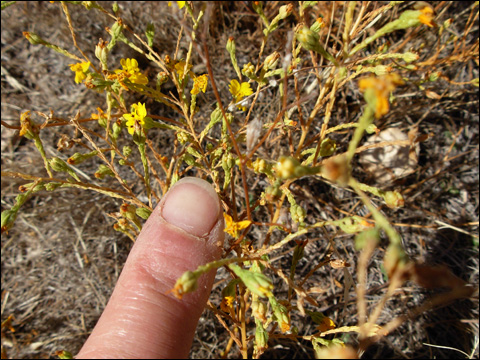
Madia species
Tidy tips (Layia platyglossa): The seeds were gathered and eaten by the Ohlone (Bocek 1984:254). This delightful wild flower can carpet large areas in April and May in places where tall grasses do not compete with it (author).
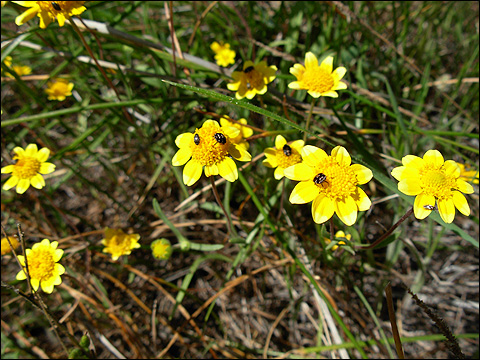
Tidy tips
Yellow carpet (Blennosperma californicum): Powers documents it’s seed was used, but not for a specific culture (Powers 1976:425).
BERRIES / FRUIT
Blue elderberry (Sambucus mexicana): California Indians ate the fruit (Timbrook 2007:195). Fresh fruit in quantity can cause nausea and vomiting. Cooking reduces this problem (Fuller and McClintock 1986:116). This shrub-like tree with pith-filled branches produces quantities of fruit eaten by Native Peoples most everywhere the plant occurs. Harrington’s notes confirm Ohlone Peoples ate elderberries also (Bocek 1984:254). Other reported uses of the elderberry by Ohlone included arrow shaft material from small diameter hollow branches, fire spindles, pipe stems, and the California flute (Timbrook 2007:225 from Bocek 1984:249). The plant was also commonly used for ceremonial clapper sticks by neighboring groups. I have not yet found a record of traditional use of clapper sticks by the Ohlone, though it is likely they did. The fruit ripens from August through September in the Bay Area (author).
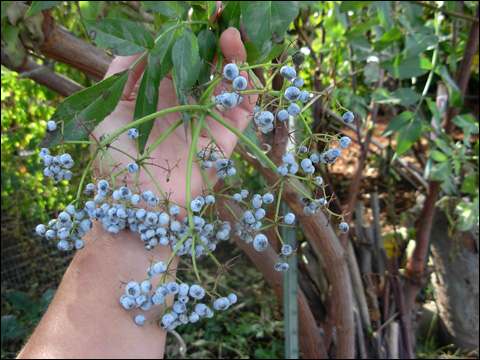
Blue elderberry
Blue witch nightshade (Solanum umbelliferum): This little shrub graces rocky and clay soil with yellow flowers and fruit which ripens purple, like a tiny eggplant. It is in the same family as tomato and eggplant, but is said to contain some toxic alkaloids. It is listed by Harrington’s Ohlone informants as an edible berry (Bocek 1984:253). However, since the preparation is undocumented, great caution should be used by anyone curious about the taste.
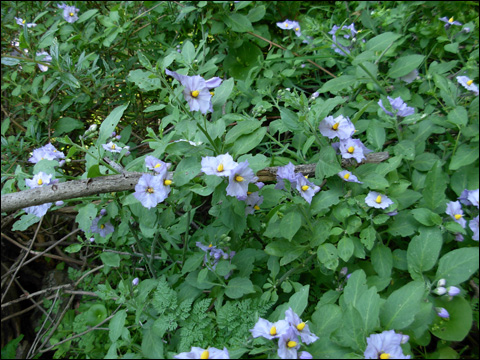
Blue witch nightshade
California blackberry, Pacific coast dewberry (Rubus ursinu, syn R. vitifoliuss): California blackberry is documented as used by the Ohlone (Bocek 1984:250). This native berry has 3 leaflets. The more obvious blackberry of local roadsides is usually the introduced species called the Himalayan blackberry (Hickman, 1993:676). It has 5 leaflets. The introduced berry was not available to Ohlone Peoples before 1769 (author).
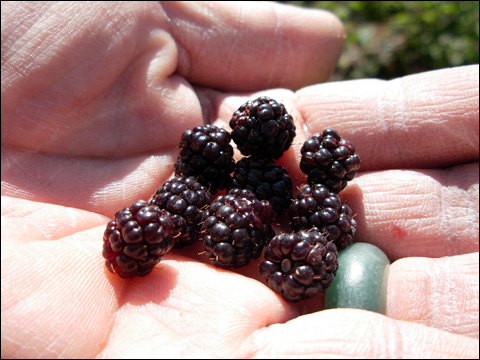
California blackberry
California huckleberry (Vaccinium ovatum): It’s delicious fruit, not unlike a small blueberry. It ripens in late August/early September (author). It was a favorite of the Ohlone (Bocek 1084:252).
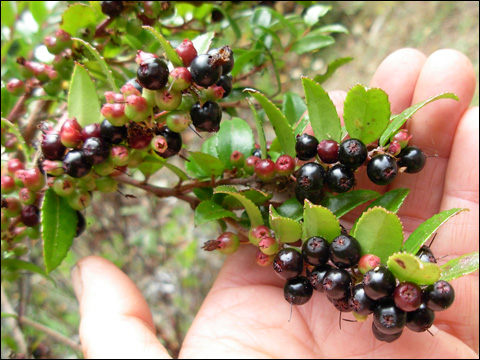
California huckleberry
California juniper (Juniperus californica): Harrington’s notes indicate the Ohlone ate the berries, though the informant indicated the taste was poor (Bocek 1984:248).
California wild grape (Vitus californicus): Ohlone ate the fruit raw (Timbrook 2007:225 from Bocek 1984:2, 51). This native riparian grape grows up into the canopy of streamside trees. Its grapes contains large seeds, but they are sweet in summer when it ripens (author).
Coffee berry (Rhamnus californica): Ohlone sometimes ate these berries raw (Bocek 198:250).
Currants and Gooseberries (Ribes spp.): Berries were eaten by Ohlone Peoples (Bocek 1984:250). No species of this group was individually identified, but all are apparently edible. By my own estimation, they vary in flavor, but are quite enjoyable (author).
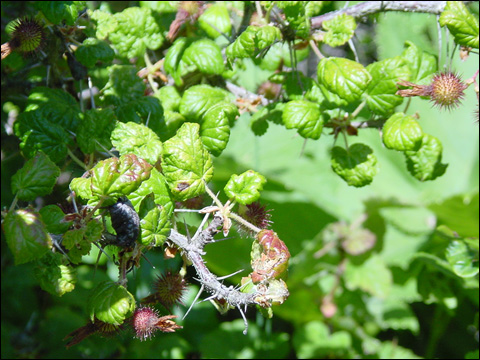
Gooseberry
False solomon’s seal (Similacina racemosa): The red berry was eaten by the Ohlone (Bocek 1984:255).
Holly leaf cherry (Prunus ilicifolia): See Nuts.
Madrone (Arbutus menziesii): Berries were gathered and eaten, but only in small quantities (Bocek 1984:252). I’ve eaten the berry and found it quite enjoyable when ripe. The berry is often high in the tree and only available when blown down (author).
Manzanita (Arctostaphylos spp.): Ohlone Peoples gathered manzanita berries, eating the fruit raw, or making a cider by soaking the berries in cold water (Beverly Ortiz from Bocek 1984), (Powers 1976:422). Manzanita cider was also made by neighboring groups, including the Yokuts (Mayfield 1929:66-106). Fruit matures in the summer and can be found dried on the bushes through September. This is a big summer treat at our house (author).
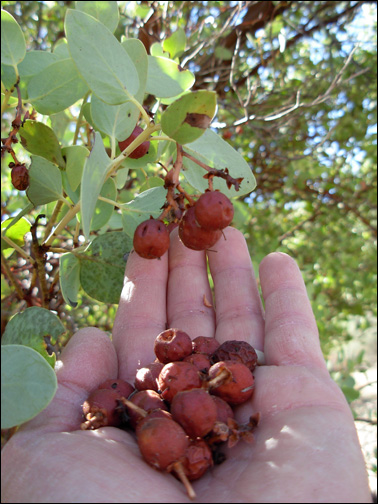
Manzanita berries
Service berry (Amelanchier pallida syn A. utahensis): This fruit resembling a blueberry was eaten raw by the Ohlone (Bocek 1984:249).
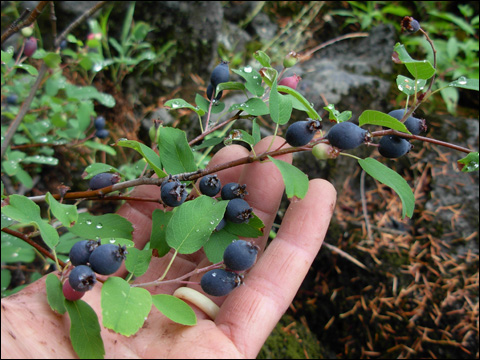
Service berry
Thimbleberry (Rubus parviflorus): This berry grows within Ohlone territory. I have not found a reference to its use, but as a plant common to our coast, it is hard to believe it was overlooked by the Ohlone Peoples. Fruit ripens in July/August and varies in quality from dry and insipid to juicy and flavorful (author).
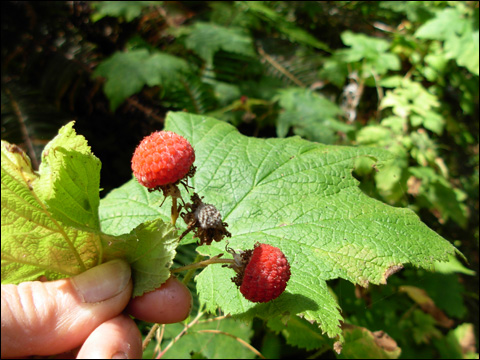
Thimbleberry
Toyon (Hetermles arbutifolia): Ohlone Peoples ate the berries toasted or dried (Timbrook 2007:94 from Bocek 1984:249), (Bocek 1984:249). Toyon berry is available in December (author’s experience).
Western chokecherry (Prunus virginiana): Fruits were eaten, but only late in the season (Bocek 1984:249), apparently when they were at maximum ripeness. Some astringent fruits (like American persimmon) improve in flavor after a first frost (author).
Western raspberry, Whitebark raspberry (Rubus leucodermis): The berry is listed by Harrington as used by the Ohlone (Bocek 1984:250).
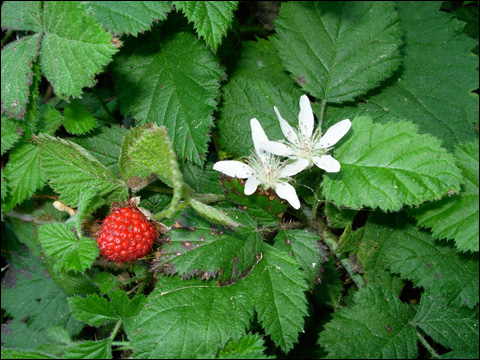
Western raspberry
Wild strawberry (Fragaria spp.): These diminutive fruits were eaten by the Ohlone (Bocek 1984:249).
ROOT CROPS OR GEOPHYTES
Called “cacomites” or “wild onion” or “amole” by the Spanish, these words implied an underground origin of a starch-rich plant structure such as a bulb, corm, tuber or rhizome. The exact species implied by each seems to vary depending on the speaker and the interpreter. Many of these are also beautiful wildflowers. It is suggested that Ohlone Peoples of the East Bay moved to camps in surrounding hills during the spring season to gather these root crops (Bean 1994:52). It should be noted that California Indians engaged in seasonal burning. The use of fire promoted the growth of this food resource. Regular digging (with digging sticks) promoted the dispersal of small cormlets, essentially replanting the area harvested. This is another example of land management practice characteristic of Indian cultures in California (author). Near Tulare, the Indians gathered roots/corms after the stems of the flowers had dried (Mayfield,1929:67). Such timing coincides with seed maturity, ensuring the falling of ripe seed into the area disturbed by digging, effectively re-seeding the area. Early in 2009, I experimented with planting some seeds of Dichelostemma. They grew, but have not flowered yet. This year, one year and a half later, I emptied what looked like their now barren 8 inch pot to find nearly 200 small corms nestled near the base (author).
Anyone interested in gathering or tasting these foods should keep several things in mind. First, gathering a plant's underground structure will kill it. Secondly, death camas grows in the same habitat as some of these root crops. Your life may depend on proper identification. Remember, private property requires owner permission and gathering in parks is prohibited.
Beavertail grass nut (Cyclobothra): It is identified by Powers as a food resource, but he did not identify the Native group (Powers 1976:424-425). Beavertail grass is apparently a common name for several of the Calochortus bulbs. Cyclobothra are a subgroup of Calochortus with hairy interior that bears a nectary. Both pussy ears/cats ears and Calochortus luteus are listed under this group by Chestofbooks.com.
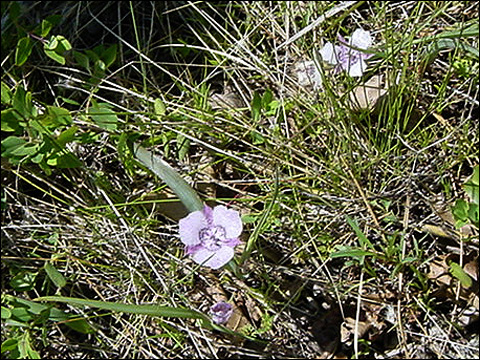
Cats ears
Blue dicks (Dichelostemma capitatum): Flowers in March to April (Bocek 1984:255).
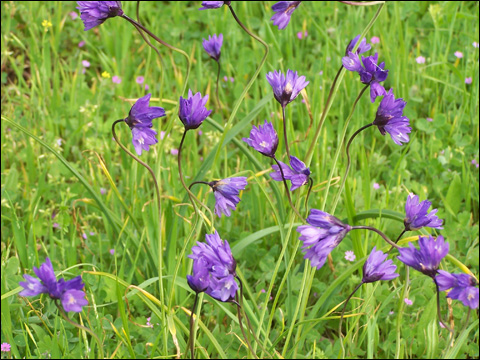
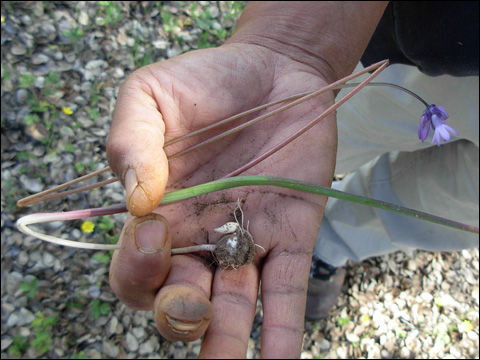
Blue dicks
Itheriel’s spear (Triteleia laxa): Flowers in late May.
Harvest brodiaea (Brodiaea elegans): Miwok cooked this bulb in a pit oven for 1 hour, adding water at the edges of the pit to create steam (Jacknis 2004:60). Harrinton lists this as a bulb (Brodiaea spp., syn cacomite), which was eaten by the Ohlone either parched or roasted (Bocek 1984:255).
Mariposa lilies (Calochortus spp.): These large edible bulbs occur within the San Francisco Bay Area and Ohlone territory. Cooked bulbs are mentioned in Spanish diaries, but I have not found accounts to be specific. This same bulb was cooked by the Sierra Miwok until it was soft (about 20 minutes) in the ashes of a fire (Jacknis 2004:57). I’ve tasted a raw bulb of Calochortus luteus and found it sweet and crunchy, not unlike an apple. It flowers in late March to June (author).
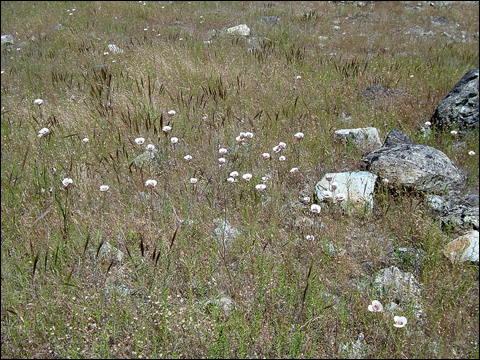
Butterfly tulips
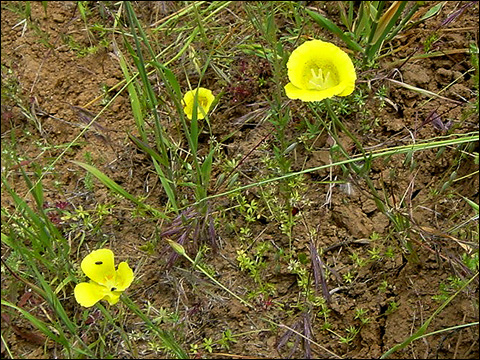
Calochortus luteus
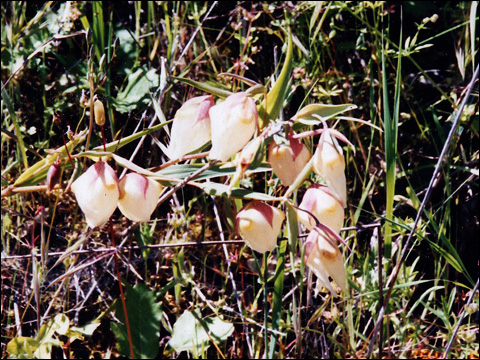
Globe lilly
Soap plant, Amole (Chlorogalum spp.): Some native groups ate the bulbs of this plant after roasting them in ashes (Timbrook 2007:57). Father Juan Crespi’s notes indicate the Ohlone cooked this bulb and offered it as food to the Spanish soldiers (Bean 1994:19). Powers also documents its use and states it was roasted underground for 36 hours (unidentified culture) (Powers 1976:423, 424). Harrington’s Ohlone informants confirm its use (Bocek 1984:255).
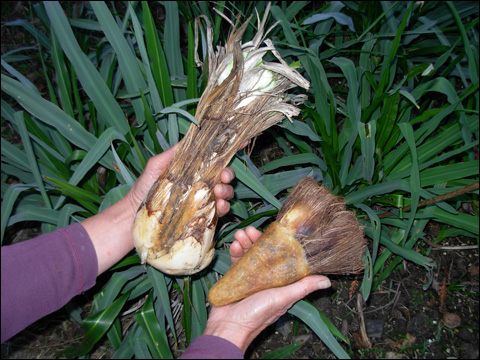
Soap plant bulb and soap root brush.
OTHER ROOT CROPS
California harebell, Nodding harebell (Campanula prenanthoides): The “bulbs” were eaten by the Ohlone in winter and early spring (Bocek 1984:254).
Cattail (Typha spp.): Ohlone ate cattail roots, the young shoots and the yellow pollen (Timmbrook 2007:220 from Bocek 1984: 255), (Bocek 1984:255).
Tule (Schoenoplectus spp., syn Scirpus spp.): The roots (rhizomes) are starchy and were eaten either raw or ground into flour and cooked by the Yokuts (Mayfield 1993: 66). Harrington’s notes confirm the same use by the Ohlone (Bocek 1984:255). Beverly Ortiz states the starchy rhizome was processed into flour and used as food (from her EBRPD handout on ethnobotany).
Sword fern (Polystichum munitum munitum): Harrington’s notes indicate the rhizomes were either boiled, or baked in coals and eaten (Bocek 1984:247).
Wild onion (Alium falsifolium): Bulb was eaten (Powers 1976:424-425, 428). It is also listed by Harrington as gathered by the Ohlone in winter and eaten (Bocek 1984:255).
Wood fern or Shield fern (Dryopteris arguta): The rhizome was gathered in the spring and eaten (Bocek 1984:247).
Yellow nut sedge, Chufa sedge, Tiger nut sedge (Cyperus esculentus): This grass like sedge grows from edible underground tubers. Although it is cultivated elsewhere, it is a native of California and is identified as a food utilized by the Ohlone (Bocek 1984:255). They have excellent nutritional qualities with a fat composition similar to olives and a rich mineral content, especially phosphorus and potassium (Wikipedia website).
![]()
We hope the information on the PrimitiveWays website is both instructional and enjoyable. Understand that no warranty or guarantee is included. We expect adults to act responsibly and children to be supervised by a responsible adult. If you use the information on this site to create your own projects or if you try techniques described on PrimitiveWays, behave in accordance with applicable laws, and think about the sustainability of natural resources. Using tools or techniques described on PrimitiveWays can be dangerous with exposure to heavy, sharp or pointed objects, fire, stone tools and hazards present in outdoor settings. Without proper care and caution, or if done incorrectly, there is a risk of property damage, personal injury or even death. So, be advised: Anyone using any information provided on the PrimitiveWays website assumes responsibility for using proper care and caution to protect property, the life, health and safety of himself or herself and all others. He or she expressly assumes all risk of harm or damage to all persons or property proximately caused by the use of this information.
© PrimitiveWays 2016